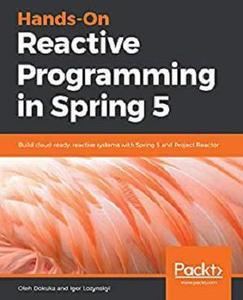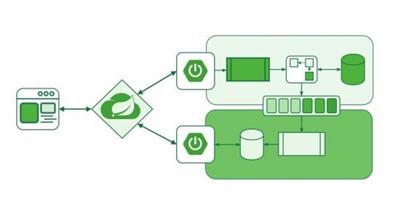Udemy - Spring RSocket
"softddl.org"
10-04-2021, 10:30
-
Share on social networks:
-
Download for free: Udemy -
-

MP4 | Video: h264, 1280x720 | Audio: AAC, 44.1 KHz, 2 Ch
Genre: eLearning | Language: English | Duration: 137 lectures (9h 35m) | Size: 4 GB
Reactive Application Series - Part 3: Develop Reactive Microservices With RSocket

MP4 | Video: h264, 1280x720 | Audio: AAC, 44.1 KHz, 2 Ch
Genre: eLearning | Language: English | Duration: 137 lectures (9h 35m) | Size: 4 GB
Reactive Application Series - Part 3: Develop Reactive Microservices With RSocket
What you'll learn:
RSocket From Scratch
RSocket Spring Boot Integration
Reactive Microservices
RSocket Routing
RSocket Security
SSL / TLS
RSocket Load Balancing
RSocket Various Interaction Models
Requirements
Java Reactive Programming
Comfortable With Indian Accent
Description
Reactive Socket aka rSocket is a binary protocol & one of the hottest technologies in the recent years from Netflix. It provides Reactive-Streams support for client and server communication. It enables us to develop fully non blocking asynchronous Microservices.
What are the advantages of using RSocket?
RSocket is a binary protocol works at layer 5/6 - It is a lot faster compared to HTTP which works at network layer 7.
RSocket uses Persistent TCP connection. (Server can also call Client)
RSocket supports Reactive Streams. (non-blocking and asynchronous communication between client and server applications).
Provides various interaction models along with standard Request and Response model.
RSocket Interaction Models:
Request Response: Standard request and response model.
Fire and Forget: Fire-and-forget is a request/response that is useful when a response is not needed. It allows for significant performance optimizations, not just in saved network usage by skipping the response, but also in client and server processing time as no bookkeeping is needed to wait for and associate a response or cancellation request. This interaction model is useful for use cases such as non-critical event logging.
Request Stream: A single request which can produce multiple responses. For example Google Search - a single keyword search could result millions of search results. We can use Request Stream model to provide streaming responses to the caller. The caller can cancel responses at any time.
Request Channel (Bi Directional Streaming): Client/Server or Server-to-Server interact with streaming requests and responses. We can develop Games!! We will develop one in this course.
What will you learn from this course?
By the end of this course, You would be comfortable with,
RSocket
Spring Integration
RSocket Routing
Various interaction models and its usage
Connection setup
Managing Connections
Cancellation
Application Flow Control
Disposing Connections
Connection Retry
Session Resumption
Server Calling Clients
Peer to Peer messaging
Server calling client
Error Handling
onerrorReturn
defaultIfEmpty
@MessageExceptionHandler
Metadata Push
SSL / TLS
Connection Level Authentication and Authorization
Request Level Authentication
Load Balancing
Server side
Client Side
A lot of hands on with Java Reactive Programming
Developing Microservices
Developing CRUD applications
Integration with Spring Data Reactive MongoDB
Client Server Game as Assignment
Server Sent Events
Who this course is for
Any Developer / Architect who is interested in Microservice Development / Architecture
Homepage
https://www.udemy.com/course/spring-rsocket
Buy Premium From My Links To Get Resumable Support,Max Speed & Support Me

https://uploadgig.com/file/download/212bcebCbFa57B93/x4tup.Spring.RSocket.part1.rar
https://uploadgig.com/file/download/aE1ef932D036397a/x4tup.Spring.RSocket.part2.rar
https://uploadgig.com/file/download/09dE58e7A8f742bc/x4tup.Spring.RSocket.part3.rar
https://uploadgig.com/file/download/214Af899A5f8f024/x4tup.Spring.RSocket.part4.rar
https://uploadgig.com/file/download/df9A259a6190e204/x4tup.Spring.RSocket.part5.rar

https://rapidgator.net/file/82110c79b5fb6c8afe9c6697c6f5ef13/x4tup.Spring.RSocket.part1.rar.html
https://rapidgator.net/file/65637dc716f5d0c0f60cc22082506c27/x4tup.Spring.RSocket.part2.rar.html
https://rapidgator.net/file/5a0d8082c25683c8a2977f314b375dd0/x4tup.Spring.RSocket.part3.rar.html
https://rapidgator.net/file/ccdcc230d0690dc093fcd285aa13687e/x4tup.Spring.RSocket.part4.rar.html
https://rapidgator.net/file/6bdeed9198b2b34aac0038c729c4e755/x4tup.Spring.RSocket.part5.rar.html

http://nitroflare.com/view/D6FD0F26005B1ED/x4tup.Spring.RSocket.part1.rar
http://nitroflare.com/view/7044B7748D044B7/x4tup.Spring.RSocket.part2.rar
http://nitroflare.com/view/104AD0572BA0785/x4tup.Spring.RSocket.part3.rar
http://nitroflare.com/view/DFB4CAE3C36B42A/x4tup.Spring.RSocket.part4.rar
http://nitroflare.com/view/F908319B8DF816B/x4tup.Spring.RSocket.part5.rar
Links are Interchangeable - No Password - Single Extraction
The minimum comment length is 50 characters. comments are moderated


![Udemy - Complete Java Reactive Programming [ From Scratch ]](https://i114.fastpic.ru/big/2021/0221/d9/7317485cbec3e6309bd890187171c3d9.jpeg)

